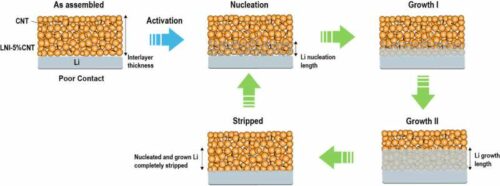The solid-state battery technology increases efficiency and safety, offering advancements for electric vehicles and electronic devices globally.

Over the past decades, engineers and chemists’ concerted efforts to address the electronics industry’s escalating needs have given rise to new battery technologies, including the advent of all-solid-state batteries (ASSBs). These batteries feature a solid electrolyte positioned between two electrodes. They are recognized for their potential to enhance energy density and safety, significantly improving traditional lithium-ion batteries. However, the widespread adoption of all-solid-state lithium-metal batteries (ASSLBs) has been hindered by challenges such as the growth of Li dendrites and high interface resistance, which can markedly degrade their performance.
As detailed in Nature Energy, researchers at the University of Maryland have introduced a new principle for crafting safe and high-energy all-solid-state lithium-metal batteries (ASSLBs). This innovative principle can potentially advance the development of more potent and dependable fuel cells for use in electric vehicles and extensive robotic systems.
The team’s primary goal in their recent research was to find an effective method to reduce Li-dendrite formation in all-solid-state lithium-metal batteries (ASSLBs). They suggested adding a unique layer between the lithium anode and the solid electrolyte within the battery cells to accomplish this.
In their research, the team applied their design concept to produce a [email protected]/Li6PS5Cl/20 µm-Li battery cell boasting an area capacity of 2.2 mAh cm^-2. Early testing revealed that these cells exhibited outstanding performance, maintaining 82.4% of their original capacity after 350 operational cycles at 60°C with a charge-discharge rate of 0.5 C.
The innovative design principle proposed by the team has the potential to be utilized across various all-solid-state batteries (ASSBs), offering a solution to inhibit the formation of Li-dendrites and thereby boost battery efficiency. Consequently, this breakthrough could create numerous safe and high-performance battery technologies with solid electrolytes, potentially revolutionizing the power sources for electric vehicles and other sizable electronic devices.
Reference: Zeyi Wang et al, Lithium anode interlayer design for all-solid-state lithium-metal batteries, Nature Energy (2024). DOI: 10.1038/s41560-023-01426-1






